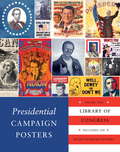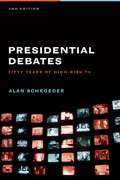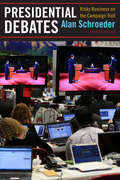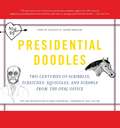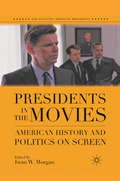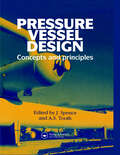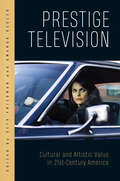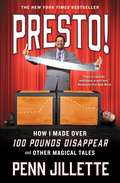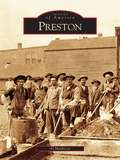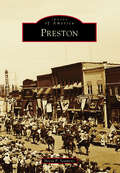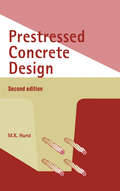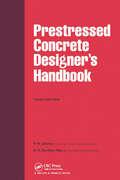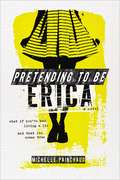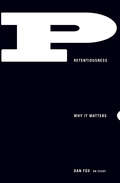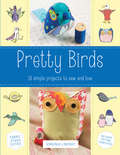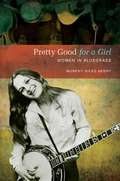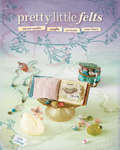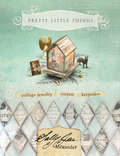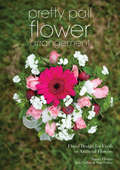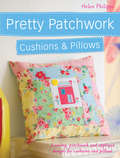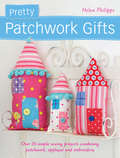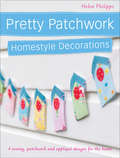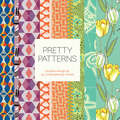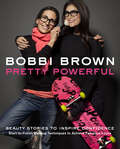- Table View
- List View
Presidential Campaign Posters: Two Hundred Years of Election Art
by The Library Of CongressHere are 100 ready-to-frame political campaign posters from the annals of American history! The candidates range from Andrew Jackson ("Defender of Beauty and Booty") and William Henry Harrison ("Have Some Hard Cider!") to Richard Nixon ("He's the One!"), Barack Obama ("Hope"), and many, many more. The posters are backed with colorful historical commentary and additional artwork; best of all, they're bound with clean microperforated edges so they can be removed, framed, and displayed. Presidential Campaign Posters is the perfect gift for political junkies of all ages!
Presidential Debates: Fifty Years of High-Risk TV
by Alan SchroederAlan Schroeder's popular history now covers the 2000 Bush-Gore and 2004 Bush-Kerry debates, including innovations in format and press coverage, and adds new research on televised debates since 1960. Schroeder organizes his book according to a television production timeline, highlighting the importance of pre- and postdebate periods, as well as the live telecasts themselves. He describes production in painstaking detail, from the selection of questioners to camera angles, from makeup to lighting and set design. Televised debates represent a rare departure from well-choreographed campaigns, and new media such as YouTube continue to reshape form and content. Conducting interviews with journalists and industry insiders, and drawing on his own experience as an award-winning reporter and television producer, Schroeder delivers a fascinating backstage tour of every aspect of debate performance.
Presidential Debates: Risky Business on the Campaign Trail
by Alan SchroederAlan Schroeder's big-picture history recounts the phenomenon of American televised presidential debates and its evolution over the past half century. From pundits to political operatives, from debate moderators to the viewing public, Presidential Debates reveals how the various stakeholders make and experience this powerful event. For this third edition, Schroeder analyzes the presidential debates of 2008 and 2012 and the crucial role that social media and contemporary news outlets had in shaping their design and reception. He also expands his coverage of previous campaigns, including the landmark meetings in 1960 between John F. Kennedy and Richard Nixon. Schroeder details an insider's view of the key phases of the debate: anticipation, in which the campaigns negotiate rules, formulate strategy, and steer press coverage; execution, in which the candidates, moderators, panelists, and television professionals create and project the event; and reaction, in which the commentators, spin doctors, and viewers evaluate the performance and move story lines in new directions. New chapters focus on real-time debate responses and the extent to which postdebate news coverage influences voters' decision making and candidates' behavior.
Presidential Doodles: Two Centuries of Scribbles, Scratches, Squiggles, and Scrawls from the Oval Office squiggles & scraw
by Cabinet MagazineWhat were the leaders of the free world really doing during all those meetings? As the editors of Cabinet magazine reveal here for the first time, they were doodling. Our Founding Fathers doodled, and so did Andrew Jackson. <P><P>Benjamin Harrison accomplished almost nothing during his time in the White House, but he left behind some impressive doodles. During the twentieth century-as the federal bureaucracy grew and the meetings got longer-the Presidential doodle truly came into its own. Theodore Roosevelt doodled animals and children, while Dwight Eisenhower doodled weapons and self-portraits. FDR doodled gunboats, and JFK doodled sailboats. Ronald Reagan doodled cowboys and football players and lots of hearts for Nancy. The nation went wild for Herbert Hoover's doodles: A line of children's clothing was patterned on his geometric designs. Cabinet magazine has spent years scouring archives and libraries across America, unearthing hundreds of Presidential doodles. Here the editors of Cabinet present the finest examples of the genre. Historian David Greenberg sets these images in context and explains what they reveal about the inner lives of our Commanders in Chief. Are Kennedy's dominoes merely squiggles, or do they reflect deeper anxieties about the Cold War? Why did LBJ and his cabinet spend so much time doodling caricatures of one another? Smart, revealing, and hilarious-Presidential Doodles is the ideal gift for anyone interested in politics or history. And for anyone who doodles!
Presidents in the Movies
by Iwan W. MorganCinematic depictions of real U. S. presidents from Abraham Lincoln to George W. Bush explore how Hollywood movies represent American history and politics on screen. Morgan and his contributors show how films blend myth and reality to present a positive message about presidents as the epitome of America's values and idealism until unpopular foreign wars in Vietnam and Iraq led to a darker portrayal of the imperial presidency, operated by Richard Nixon and Bush 43. This exciting new collection further considers how Hollywood has continually reinterpreted historically significant presidents, notably Abraham Lincoln, Theodore Roosevelt, and Franklin D. Roosevelt, to fit the times in which movies about them were made.
Pressure Vessel Design: Concepts and principles
by J. Spence A. S. ToothThis book derives from a 3 day intensive course on Pressure Vessel Design given regularly in the UK and around the world since 1986. It is written by experts in their field and although the main thrust of the Course has been directed to BS5500, the treatment of the material is of a general nature thus providing insight into other national standards
Prestige Television: Cultural and Artistic Value in Twenty-First-Century America
by Murray Leeder Javier Ramirez Seth Friedman Catherine Martin David R. Coon Amanda Keeler Justin O. Rawlins Andrew J. Bottomley Wyatt D. Phillips Josie Torres BarthPrestige Television explores how a growing array of 21st century US programming is produced and received in ways that elevate select series above the competition in a saturated market. Contributing authors demonstrate that these shows are positioned and understood as comprising an increasingly recognizable genre characterized by familiar markers of distinction. In contrast to most accounts of elite categorizations of contemporary US television programming that center on HBO and its primary streaming rivals, these essays examine how efforts to imbue series with prestigious or elevated status now permeate the rest of the medium, including network as well as basic and undervalued premium cable channels. Case study chapters focusing on diverse series, ranging from widely recognized examples such as The Americans (2013-2018) and The Knick (2014-15) to contested examples like Queen of the South (2016-2021) and How I Met Your Mother (2005-2014), highlight how contributing authors extend conceptions of the genre beyond expected parameters.
Presto!: How I Made Over 100 Pounds Disappear and Other Magical Tales
by Penn JillettePenn Jillette’s New York Times bestselling account of his “extremely funny and somewhat profane journey to discovering a healthy lifestyle…that will motivate others to seek weight-loss solutions” (The Washington Post).More than three hundred and thirty pounds and saddled with a systolic blood pressure reading at dangerous heights, legendary magician Penn Jillette found himself at a crossroads. He needed a drastic lifestyle change if wanted to see his small children grow up. Enter Crazy Ray. A former NASA scientist and unconventional, passionate innovator, Ray Cronise changed Penn Jillette’s life with his wild “potato diet.” In Presto, Jillette takes us along on his journey from skepticism to the inspiring, life-changing momentum that transformed the magician’s body and mind. He describes the process in hilarious detail, as he performs his Las Vegas show, takes meetings with Hollywood executives, hangs out with his celebrity friends and fellow eccentric performers, all while remaining a dedicated husband and father. Throughout, he weaves in his views on sex, religion, and pop culture, making his story a refreshing, genre-busting account. Outspoken, frank, and bitingly clever, Presto is an incisive, rollicking read. In the end, it is “undeniably inspiring” (Booklist).
Preston
by Al MathisonNestled in a lush valley along the banks of the Root River, Preston, Minnesota, is ideally located at the geographic center of Fillmore County. The earliest settlers found the area rich with everything they needed to build a community: timber, building stone, water power, and fertile soils. By 1860, Preston was a bustling business and government center in the heart of the most populous county in Minnesota. With rare and vintage photographs culled from the collection of the Fillmore County History Center, as well as from the albums and scrapbooks of many local residents, this book brings together nearly 200 images of Preston and its environs.
Preston
by Necia P. SeamonsKnown first as Worm Creek because of a stream winding through dry bluffs, Preston, Idaho, blossomed as its first residents harnessed life-giving waters from surrounding mountains. The first homesteaders, who arrived in 1866, hauled lots of water, often wondering if their efforts to tame Mother Nature would ever pay off. On his way to Bear Lake, Brigham Young, colonizer of the West and president of the Church of Jesus Christ of Latter-day Saints, had his driver stop near the present business district of Preston. Placing his cane to the ground, he said, "There will be a great city built here." Today, Preston is a pretty great place.
Prestressed Concrete Design
by M. K. HurstPrestressed concrete is widely used in the construction industry in buildings, bridges, and other structures. The new edition of this book provides up-to-date guidance on the detailed design of prestressed concrete structures according to the provisions of the latest preliminary version of Eurocode 2: Design of Concrete Structures, DD ENV 1992-1-1: 1992. The emphasis throughout is on design - the problem of providing a structure to fulfil a given purpose - but fundamental concepts are also described in detail. All major topics are dealt with, including prestressed flat slabs, an important and growing application in the design of buildings. The text is illustrated throughout with worked examples and problems for further study. Examples are given of computer spreadsheets for typical design calculations. Prestressed Concrete Design will be a valuable guide to practising engineers, students and research workers.
Prestressed Concrete Designer's Handbook
by P.W. Abeles B K Bardhan-RoyThe third edition of this authoritative handbook provides the structural designer with comprehensive guidance on prestressed concrete and its effective use, covering materials, behaviour, analysis and design of prestressed elements. It includes numerous examples, design charts and details of post-tensioning systems.
Pretending to Be Erica
by Michelle PainchaudWe Were Liars meets Heist Society in a riveting debut!Seventeen-year-old Violet's entire life has revolved around one thing: becoming Erica Silverman, an heiress kidnapped at age five and never seen again. Violet's father, the best con man in Las Vegas, has a plan, chilling in its very specific precision. Violet shares a blood type with Erica; soon, thanks to surgery and blackmail, she has the same face, body, and DNA. She knows every detail of the Silvermans' lives, as well as the PTSD she will have to fake around them. And then, when the time is right, she "reappears"--Erica Silverman, brought home by some kind of miracle. But she is also Violet, and she has a job: Stay long enough to steal the Silverman Painting, an Old Master legendary in the Vegas crime world. Walking a razor's edge, calculating every decision, not sure sometimes who she is or what she is doing it for, Violet is an unforgettable heroine, and Pretending to be Erica is a killer debut.
Pretentiousness: Why It Matters
by Dan FoxPretentiousness is for anyone who has braved being different, whether that's making a stand against artistic consensus or running the gauntlet of the last bus home dressed differently from everyone else. It's an essential ingredient in pop music and high art. Why do we choose accusations of elitism over open-mindedness? What do our anxieties about "pretending" say about us? Co-editor of frieze, Europe's foremost magazine of contemporary art and culture, Dan Fox has authored over two hundred essays, interviews, and reviews and contributed to numerous catalogues and publications produced by major international art galleries and institutions.
Pretty Birds: 18 Simple Projects to Sew and Love
by Virginia LindsayCreate colorful peacocks, cheerful canaries, and adorable penguins with these simple, beautiful projects to sew and love. With pattern templates included and step-by-step instructions, you can creatively put together pretty bird crafts for your friends, and even more for yourself! The birds you create are not just unique and cute decorations but also little critters than can double as plushies, pillows, and more. Before you know it you’ll have dozens of unique birds decorating your home. Pretty Birds is a must-have for avid bird lovers and crafters alike.
Pretty Good for a Girl: Women in Bluegrass (Music in American Life)
by Murphy Hicks HenryThe first book devoted entirely to women in bluegrass, Pretty Good for a Girl documents the lives of more than seventy women whose vibrant contributions to the development of bluegrass have been, for the most part, overlooked. Accessibly written and organized by decade, the book begins with Sally Ann Forrester, who played accordion and sang with Bill Monroe's Blue Grass Boys from 1943 to 1946, and continues into the present with artists such as Alison Krauss, Rhonda Vincent, and the Dixie Chicks. Drawing from extensive interviews, well-known banjoist Murphy Hicks Henry gives voice to women performers and innovators throughout bluegrass's history, including such pioneers as Bessie Lee Mauldin, Wilma Lee Cooper, and Roni and Donna Stoneman; family bands including the Lewises, Whites, and McLains; and later pathbreaking performers such as the Buffalo Gals and other all-girl bands, Laurie Lewis, Lynn Morris, Missy Raines, and many others.
Pretty Little Felts: Mixed-Media Crafts To Tickle Your Fancy
by Julie CollingsA pretty little twist on feltWool felt offers endless crafting possibilities - it feels soft to the touch, dyes easily, cuts without fraying and sews like a dream. When you combine felt with mixed-media elements such as paper, beads, buttons, lace, glitter and even bits of metal screen, you can make all kinds of magical creations, from zippered pouches and scented pincushions to unexpected jewelry and sweet fairy dolls. Pretty Little Felts includes instructions and inspiration for more than 20 whimsical projects, as well as:A helpful techniques section with step-by-step instructions for embroidery stitches, dyeing felt, wet felting beads and deconstructing vintage wool garmentsNumerous variation projects to spark your imagination and inspire you to put your own spin on the author's clever charm bracelets, ornaments, pouches and moreAn extensive resources list to help you find all the materials you need to make your felt and mixed-media creationsGet out your collection of quirky treasures and prized vintage finds and give them new life in your own Pretty Little Felts.
Pretty Little Things: Collage Jewelry, Trinkets and Keepsakes
by Tonia Davenport Sally Jean AlexanderWhimsical and Elegant Projects from Well-Known Collage Artist Sally Jean Alexander With Pretty Little Things, readers will find collage projects that exhibit a playful air and a sense of magic. The 27 projects and 30 variations feature vintage ephemera soldered within glass, for finished works that tell a romantic or whimsical story. All exhibit Sally Jean Alexander's signature style - a style that brings new life to antique papers, vintage photographs, found projects, scavenged text, and more.
Pretty Packages
by Madelene FarinWith just a few simple steps, blogger Sally J Shim shows readers how to turn an ordinary package into a customized present as special as the gift within. From a stitched garland topper and watercolor wrapping paper to a confetti gift tag, each of the 45 creative and achievable projects offers a unique twist on gift wrapping. Plus, each project has multiple variations, leading to endless possibilities for prettying up packages. Including techniques for wrapping oddly shaped packages, ideas for creating reusable packaging (a bonus gift for the recipient!), and projects that require only basic materials, Pretty Packages will inspire gift givers as well as Etsy shop owners to make every element of their package special.
Pretty Pail Flower Arrangement
by Julie Collins Tina ParkesMake your own stunning floral table centrepieces with this beautiful and practical project from a team of award-winning master florists. With step-by-step advice, essential techniques and the option of using fresh or artificial flower, this Pretty Pail Flower Arrangement project encourages you to get creative and learn how to creaft chic and unique floral arrangements for your home, a gift or any special occasion. Project taken from Chic & Unique Flower Arrangements by Julie Collins and Tina Parkes.
Pretty Patchwork Cushions & Pillows
by Helen PhilippsSew a gorgeous handmade gift with 3 simple patchwork, applique and embroidery cushion and pillow patterns for you to make at home. Patchwork isn't just about making quilts; it's about creating smaller projects too, and sewing something pretty to treasure! Pretty Patchwork Cushions & Pillows has a tempting range of quick-to-stitch patchwork patterns to get you started. All three patterns feature beautiful appliqué cushion designs and will make the perfect adition to any home. Each chapter features easy-to-follow instructions, diagrams and templates, with gorgeous full-colour photography. Use these designs as a starting point to inspire your own creativity, and make pretty patchwork gifts for friends and family, for every occasion!
Pretty Patchwork Gifts
by Helen PhilippsGive a gorgeous handmade gift with over 25 simple patchwork patterns! Patchwork isn't just about making quilts; it's about creating smaller projects too, and sewing something pretty to treasure! This book has a tempting range of quick-to-stitch patchwork patterns to get you started; from applique cushion designs and hand-pieced doll's quilts to pretty birdhouses, brooches, boxes and even soft toy rabbits in pretty patchwork dresses. Each chapter features easy-to-follow instructions, diagrams and templates, with gorgeous full-color photography. Use these designs as a starting point to inspire your own creativity, and make pretty patchwork gifts for friends and family, for every occasion.
Pretty Patchwork Homestyle Decorations: 4 Sewing, Patchwork and Appliqué Designs for the Home
by Helen PhilippsA tempting range of 4 quick-to-stitch patchwork patterns from bestselling author Helen Philipps. These patchwork projects are simple but inspiring, with beautiful detail and lots of extra ideas. The designs make perfect handmade gifts for all occasions or pretty decorations for the home including bunting, a flower garland, a decorative wall hanging and cute little stuffed houses. Features easy-to-follow instructions, colour photos and delightful illustrations throughout
Pretty Patterns: Surface Design by 25 Contemporary Artists
by Chronicle BooksGet your creative juices flowing with this colorful collection of pattern designs from today’s most innovate and stylish artists. This beautiful lookbook celebrates oodles of groundbreaking new talent in the world of pattern design, showcasing the gorgeous work of today’s top indie artists, designers, and illustrators. Including surface art by Julia Rothman, Jill Bliss, Junzo Terada, Rifle Paper Co., Amy Butler, Sukie, and many more, Pretty Patterns features an eclectic range of more than one hundred decidedly dazzling contemporary repeats, from geometric and figurative patterns to organic and botanical designs. Every page in this enchanting catalog offers a visual treat and a wellspring of creative inspiration. This intimate and attractive little package makes an appealing gift for those who appreciate a rich, delightful design aesthetic.
Pretty Powerful: Beauty Stories to Inspire Confidence
by Bobbi BrownThe bestselling author and makeup artist gives you application techniques you can use at home and personal stories that will inspire you to be your best. Pretty Powerful is a new kind of makeup manual that starts with who you are, rather than how you look. In this book, Bobbi interviews dozens of real women, celebrities, and athletes about what beauty means to them and shows, step-by-step, how to achieve each look. Along the way, she shares her trade secrets for striking eyes, youthful skin, pretty lips, and perfect brows for any age, skin color, or beauty type. Brimming with hundreds of stunning makeover ideas, recommendations for the best tools and products, inspiring beauty stories, and expert tips not found anywhere else, Pretty Powerful is the must-have guide for lasting beauty, inside and out.Includes personal stories from:Blythe Danner, actressAlexa Ray Joel, musicianGabourey Sidibe, actressCristie Kerr, professional golferAlexandra Wilson and Alexis Maybank, co-founders of Gilt GroupeEstelle, musicianLee Woodruff, writer and advocateAnd many others!
